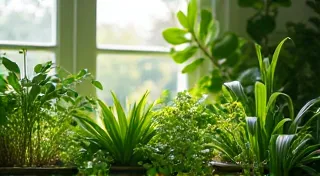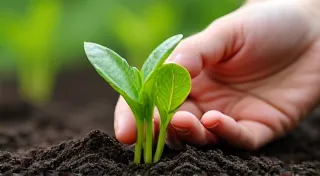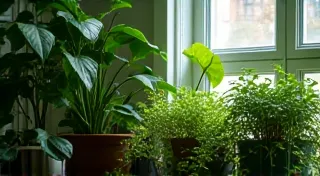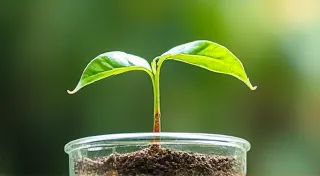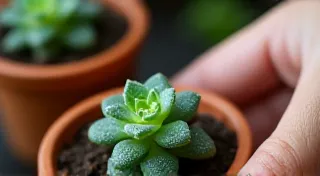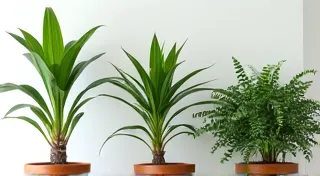Choosing the Right Pot Size: A Guide for Happy Roots
One of the most common mistakes beginner plant parents make is choosing the wrong pot size for their houseplants. It seems simple enough, but it can significantly impact your plant's health and growth. Too big, and you risk problems; too small, and your plant will quickly become root-bound. This guide breaks down how to choose the right pot size and why it’s so important. Before you even consider the pot, understanding the basics of your plant's needs is key. For example, deciphering what's on a plant label can be incredibly helpful – you might find it useful to understand plant labels to really tailor your care.
Why Pot Size Matters
The pot isn't just a container; it's a crucial part of your plant's ecosystem. Here’s why getting it right is essential:
- Root Health: Roots need space to breathe and grow. A proper pot size allows for healthy root development, which translates to a healthier plant overall.
- Watering Issues: A pot that's too large holds more soil, which retains more water. This can lead to overwatering and root rot. Conversely, a pot that’s too small dries out too quickly. Consistent watering is also key, and understanding common houseplant problems can help you troubleshoot any issues.
- Nutrient Absorption: Healthy roots are better at absorbing nutrients from the soil. A root-bound plant struggles to take up nutrients, leading to deficiencies.
- Growth & Stability: The pot needs to be proportional to the plant's size to provide adequate support.
Sizing Up: General Guidelines
Here's a simple rule of thumb for repotting:
- Small Plants (4-6 inches): Pot up to a pot that is 1-2 inches larger in diameter.
- Medium Plants (6-12 inches): Increase the pot size by 2-4 inches.
- Large Plants (over 12 inches): Consider a pot that’s 4-6 inches larger, but always assess the root system first.

Signs Your Plant Needs a New Pot
Before you start shopping for pots, observe your plant. Here are some indicators that it's time for a bigger home:
- Roots Circling the Bottom: This is the most obvious sign. Gently remove the plant from its current pot and check the roots. If they are tightly circling the inside, it's time to upsize.
- Roots Growing Through Drainage Holes: This shows the plant has completely filled the current pot.
- Slowed Growth: If your plant has stopped growing or is growing very slowly, it could be root-bound. Sometimes, the problem isn't just the pot size – other factors, like improper pruning, can also contribute to stunted growth. Learning about pruning houseplants can help revitalize a struggling plant.
- Frequent Drying Out: If the soil dries out incredibly quickly, even with regular watering, the plant might be needing a bigger pot.
- Plant Leaning: A plant that is too large for its pot will often lean noticeably.
Choosing the Right Material
The material of the pot isn's as important as the size, but it can affect watering frequency and overall plant health:
- Terracotta: Porous, allowing for good airflow and faster drying. Great for plants that don't like to stay wet.
- Plastic: Retains moisture better and is often more affordable.
- Ceramic: Can be glazed (retaining moisture) or unglazed (more porous).
Beyond Size and Material: Environmental Factors
While the right pot size and material are critical, remember that your plant’s overall health depends on more than just the container. Light, humidity, and temperature all play a crucial role. Many plants, particularly those that thrive in dimmer conditions, still benefit from the correct pot size, but might struggle if they aren't receiving enough light. If you're finding that your plant is constantly struggling despite proper watering and repotting, consider whether it's getting the right amount of light, or whether you should explore plants better suited to low-light plants.
The Impact of Rootbound Conditions
When a plant becomes severely rootbound, the roots become so tightly packed that they start to strangle the plant. They’re no longer able to efficiently absorb water and nutrients, leading to a cascade of problems. Recognizing the signs of rootbound conditions early is key to preventing long-term damage. Besides the obvious signs like circling roots and roots exiting the drainage holes, you might also notice yellowing leaves, stunted growth, and a generally unhealthy appearance. Even if you repot, the root system might be permanently damaged if the situation has been prolonged. Proper care and selecting the correct pot size in the first place is always the best prevention.
Understanding Pot Shapes and Their Effects
The shape of the pot isn't usually a primary concern, but it can influence moisture retention and stability. Taller pots can sometimes dry out faster due to increased surface area, whereas wider pots might offer more space for root development. The best choice depends on the specific plant's needs and your watering habits. For example, a plant that prefers drier conditions would likely benefit from a terracotta pot, regardless of its shape. Conversely, a moisture-loving plant might do well in a wider, ceramic pot.
Troubleshooting Common Repotting Mistakes
Even experienced plant parents can make mistakes when repotting. One of the most common is packing the soil too tightly, which can restrict root growth and lead to root rot. Remember to gently loosen the roots and use a well-draining potting mix. Another mistake is choosing a pot that's too large, which can lead to overwatering. It's always better to err on the side of caution and choose a pot that's only slightly larger than the current one.
Maintaining Healthy Roots – A Long-Term Commitment
Repotting isn’t a one-time event; it’s part of a long-term commitment to keeping your plants healthy. Depending on the plant’s growth rate and pot size, you may need to repot every 1-2 years. Regular inspection of the roots is essential to catch any signs of rootbound conditions or other problems early on. By paying attention to your plants and providing them with the right care, you can enjoy years of lush foliage and vibrant blooms.
Recap & Final Thoughts
Choosing the right pot size is a crucial step in ensuring your houseplants thrive. It’s more than just picking a pretty container; it’s about creating a supportive environment for healthy root development. By paying attention to the signs, following these guidelines, and being mindful of other factors like light and watering, you can set your plants up for a lifetime of happy roots and healthy growth.

Repotting Tips
When repotting, be gentle! Loosen the roots carefully and add fresh potting mix. Don't pack the soil too tightly.

Choosing the right pot size is a crucial step in ensuring your houseplants thrive. By paying attention to the signs and following these guidelines, you can set your plants up for a lifetime of happy roots and healthy growth.
